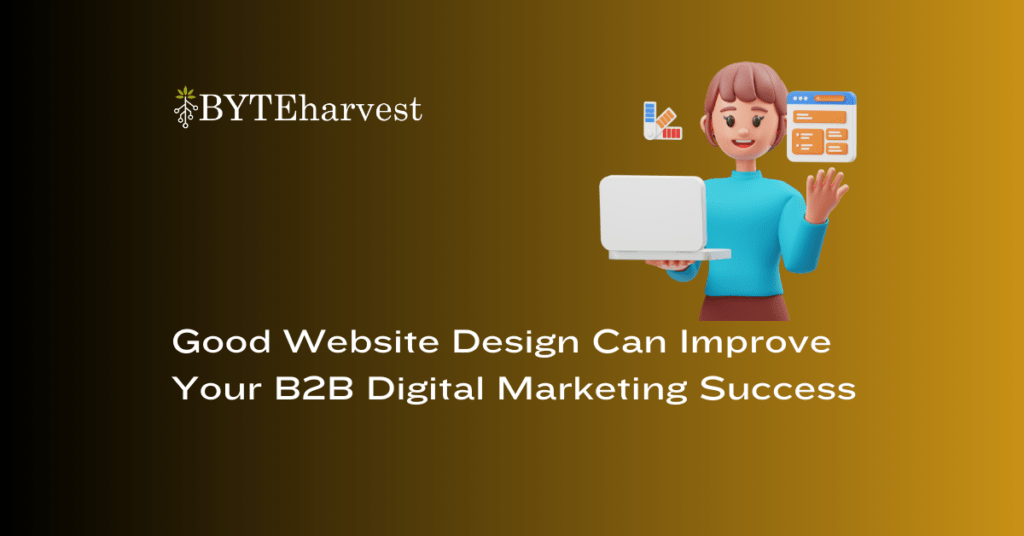Creating an effective B2B website is crucial for achieving digital marketing success. In this article, we’ll explore the importance of web design for B2B companies and how a well-designed website can significantly improve your B2B digital marketing efforts. This comprehensive guide is essential reading for any B2B company looking to enhance their online presence and boost their conversion rates.

Some of the Factors of Website Design to Improve Your B2B Digital Marketing Success:
- Understanding the Importance of Web Design for B2B Companies
- Key Elements of Effective B2B Website Design
- Optimizing User Experience (UX) for B2B Websites
- Best Practices for B2B Web Design
- The Role of SEO in B2B Website Design
- Conversion Rate Optimization for B2B Websites
- Designing for Mobile Devices in the B2B Space
- Leveraging Analytics to Improve Your B2B Website
- Building Trust Through Testimonials and Case Studies
- Creating a Seamless Navigation Experience for B2B Customers
Understanding the Importance of Web Design for B2B Companies
Web design is crucial for B2B companies as it directly impacts user experience and the effectiveness of digital marketing strategies. A good website design not only attracts visitors but also ensures that your website converts those visitors into leads and customers. For B2B companies, the website is often the first touchpoint with potential clients, making it essential to create a strong first impression.
A well-designed website reflects the professionalism and credibility of your business, which is vital in building trust with B2B customers. The design should align with your brand’s value proposition and communicate your offerings clearly. Additionally, effective B2B website design incorporates elements that address the specific pain points of your target audience, making it easier for them to find the information they need and take the desired action.
Key Elements of Effective B2B Website Design
Effective B2B website design includes several key elements that work together to create a user-friendly and persuasive online presence. These elements include:
Clear Value Proposition
Your website should clearly communicate your value proposition. Visitors should immediately understand what your business offers and how it can solve their problems. This clarity helps in attracting and retaining the right audience.
Compelling Visual Design
Aesthetics play a significant role in web design. A visually appealing website can engage visitors and keep them on your site longer. Use a clean and professional design, with a consistent color scheme and typography that reflects your brand identity.
User-Friendly Navigation
Navigation is crucial for user experience. Ensure that your website is easy to navigate with clear menus and logical structure. Visitors should be able to find the information they need with minimal effort.
High-Quality Content
Content is king in digital marketing. Provide valuable and informative content that addresses the needs and concerns of your audience. This includes blog posts, whitepapers, case studies, and other resources that demonstrate your expertise.
Optimizing User Experience for B2B Websites
User experience is a critical factor in B2B website design. A positive user experience ensures that visitors have a seamless and enjoyable experience on your website, which can lead to higher conversion rates and better customer satisfaction.
Responsive Design
With the increasing use of mobile devices, it’s essential to have a responsive design that provides a consistent experience across all screen sizes. This ensures that your website is accessible and easy to use, regardless of the device.
Fast Loading Speed
Website speed is another crucial aspect of user experience. Slow-loading pages can frustrate users and increase bounce rates. Optimize your website’s performance by minimizing file sizes, using efficient coding practices, and leveraging caching techniques.
Intuitive Layout
An intuitive layout helps users find what they’re looking for quickly. Use clear headings, bullet points, and concise text to make your content easy to scan. Group related information together and use whitespace to avoid clutter.
Best Practices for B2B Web Design
Following best practices in B2B web design can help you create a website that is both functional and attractive. Here are some best practices to consider:
Prioritize SEO
Search engine optimization (SEO) is essential for improving your website’s visibility in search engine results. Optimize your website’s content, meta tags, and images for relevant keywords to increase your search engine rankings.
Use High-Quality Images and Videos
Visual content can enhance the appeal of your website and convey complex information quickly. Use high-quality images and videos that are relevant to your products or services.
Incorporate Social Proof
Testimonials, reviews, and case studies can build trust and credibility. Feature these prominently on your website to demonstrate the success of your products or services.
The Role of SEO in B2B Website Design
SEO is a crucial component of B2B website design as it helps improve your website’s visibility and attract more organic traffic. Here are some key SEO strategies for B2B websites:
Keyword Research
Conduct thorough keyword research to identify the terms and phrases your target audience is searching for. Use these keywords strategically in your content, headings, and meta tags.
On-Page Optimization
Optimize your on-page elements, including title tags, meta descriptions, and header tags. Ensure that your content is well-structured and includes relevant keywords.
Quality Content
Create high-quality, informative content that addresses the needs of your audience. Regularly update your blog and resources section with fresh content to keep your website relevant and engaging.
Conversion Rate Optimization for B2B Websites
Conversion rate optimization (CRO) involves making improvements to your website to increase the percentage of visitors who take the desired action, such as filling out a contact form or making a purchase. Here are some CRO strategies for B2B websites:
Clear Calls to Action
Use clear and compelling calls to action (CTAs) that guide visitors towards the desired action. Make sure your CTAs stand out and are easy to find.
Simplify Forms
Simplify your contact forms by only asking for essential information. Long and complex forms can deter visitors from completing them.
A/B Testing
Conduct A/B testing to determine which design elements and content variations perform best. Use the insights from these tests to make data-driven decisions.
Designing for Mobile Devices in the B2B Space
With more B2B customers using mobile devices to access websites, it’s crucial to design your website with mobile users in mind. Here are some tips for mobile-friendly B2B website design:
Mobile-First Approach
Adopt a mobile-first approach to ensure that your website performs well on smaller screens. Design the mobile version of your website first and then scale up for larger screens.
Touch-Friendly Design
Ensure that your website’s design is touch-friendly. Buttons and links should be large enough to be easily tapped, and there should be enough space between interactive elements.
Optimize Images and Videos
Optimize images and videos for mobile devices by compressing file sizes and using appropriate formats. This helps improve loading times and provides a better user experience.
Leveraging Analytics to Improve Your B2B Website
Analytics provide valuable insights into how visitors interact with your website and where improvements can be made. Here’s how to leverage analytics for your B2B website:
Track Key Metrics
Track key metrics such as bounce rate, average session duration, and conversion rate. These metrics can help you understand user behavior and identify areas for improvement.
Use Heatmaps
Heatmaps show where users click, scroll, and spend the most time on your website. Use heatmaps to identify which areas of your website are most engaging and which areas may need adjustments.
Monitor Traffic Sources
Monitor the sources of your website traffic to understand where your visitors are coming from. This information can help you refine your marketing strategies and focus on the most effective channels.
Building Trust Through Testimonials and Case Studies
Trust is a critical factor in B2B transactions. Building trust with your audience can lead to more conversions and long-term relationships. Here’s how to use testimonials and case studies effectively:
Showcase Client Testimonials
Client testimonials provide social proof and demonstrate the value of your products or services. Feature testimonials prominently on your homepage and relevant landing pages.
Highlight Case Studies
Case studies provide detailed examples of how your products or services have helped other businesses. Highlight case studies that showcase your expertise and the positive outcomes your clients have achieved.
Use Authentic Quotes and Images
Use authentic quotes and images of your clients in testimonials and case studies. This adds credibility and makes the content more relatable.
Creating a Seamless Navigation Experience for B2B Customers
Seamless navigation is essential for providing a positive user experience and helping visitors find the information they need quickly. Here are some tips for creating effective navigation:
Simplify Menu Structure
Keep your menu structure simple and intuitive. Use clear labels and group related pages together to make it easy for visitors to navigate your site.
Use Breadcrumbs
Breadcrumbs provide a visual trail of the pages a visitor has viewed, helping them understand their current location and navigate back to previous pages.
Optimize for Search
Include a search function on your website to help visitors find specific information quickly. Ensure that your search function is accurate and provides relevant results.
Consistent Navigation Across Devices
Ensure that your navigation is consistent across all devices, including desktops, tablets, and mobile phones. This consistency helps provide a seamless experience for users, regardless of the device they are using.
Summary:
- Effective B2B website design is crucial for digital marketing success.
- Clear value propositions, compelling visual design, and user-friendly navigation are key elements.
- Optimizing UX involves responsive design, fast loading speeds, and intuitive layouts.
- Following best practices like prioritizing SEO and using high-quality visuals enhances web design.
- Conversion rate optimization can be achieved through clear CTAs, simplified forms, and A/B testing.
- Mobile-friendly design is essential for accommodating users on mobile devices.
- Leveraging analytics helps identify areas for improvement and track key.

